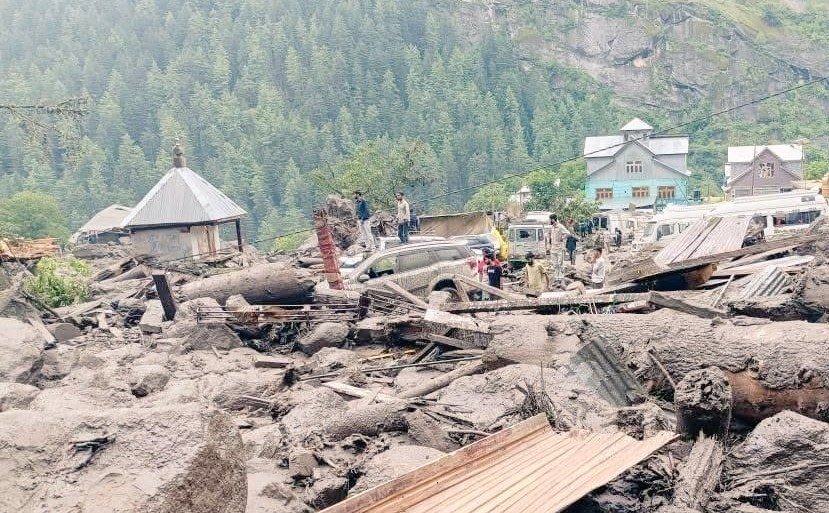Breaking update with complete on-ground analysis, survivor voices, and expert insights
By: Javid Amin | 15 Aug 2025
A Sacred Journey Turns into a Nightmare
What began as a pilgrimage of devotion turned into one of Jammu and Kashmir’s deadliest natural disasters in recent years. On August 14, 2025, just past midday, a massive cloudburst struck Chositi village in Kishtwar district — the last motorable point before the uphill trek to the revered Machail Mata temple.
The death toll has now climbed to 46, with over 100 injured and dozens still missing, according to district officials. Rescue teams fear the number could rise further as the search continues through mud, rubble, and swollen rivers.
Most victims were pilgrims gathered for the annual yatra to the 9,500-foot-high shrine. The sudden flash floods destroyed tents, makeshift shops, a langar site, and sections of the trail, leaving behind devastation and heartbreak.
Timeline of the Disaster
Morning Calm (Before 12:00 pm)
-
Pilgrims began arriving at Chositi before sunrise.
-
Langars offered tea and hot meals; devotional songs filled the air.
-
Weather was cloudy but gave no strong warning of danger.
12:15–12:45 pm — Nature’s Sudden Fury
-
A dense, dark cloud gathered over the ridgeline.
-
Rain escalated within seconds into a cloudburst, releasing a torrent of water.
-
Witnesses recall a deafening roar as flash floods rushed down, carrying mud, rocks, and debris.
Immediate Impact
-
The main langar tent was swept away.
-
Dozens of pilgrims were trapped or swept downstream.
-
One CISF official confirmed dead, three others still missing.
Rescue Mobilization
-
NDRF, SDRF, Army, and locals started immediate rescue operations.
-
Roads were blocked by landslides, forcing rescuers to trek in.
-
By nightfall, 65 people were rescued, many critically injured.
The Rescue Mission — Racing Against Time
Rescue operations have intensified with the clock ticking for dozens still unaccounted for.
Key Rescue Measures:
-
Divers deployed in fast-flowing streams to search for missing bodies.
-
Heavy machinery brought in to clear debris despite blocked approach roads.
-
Temporary field hospitals set up for triage and emergency treatment.
District Commissioner Pankaj Kumar Sharma stated:
“The terrain is treacherous and weather unpredictable. Our teams are working round-the-clock to find survivors, even if it means risking their own safety.”
Machail Mata Yatra — Faith in the Mountains
The Machail Mata temple in Paddar region is among J&K’s most sacred shrines, drawing tens of thousands each year in August.
-
Situated at 9,500 feet, accessible via a challenging trek.
-
Chositi is the last motorable point before the 8.5 km uphill journey.
-
The area becomes densely packed with pilgrims, langars, and supply stalls.
This geographic bottleneck meant hundreds were in harm’s way when the cloudburst hit.
Understanding a Cloudburst
A cloudburst is an intense rainfall event — often 100 mm+ in under an hour — over a small area. In mountains, this water rapidly turns into flash floods.
Why Deadly in Kishtwar:
-
Narrow valleys funnel water at high speed.
-
Steep slopes push debris downhill.
-
Deforestation reduces soil absorption.
Climate experts say cloudbursts are becoming more frequent in the Himalayas due to rising temperatures altering monsoon patterns.
Eyewitness Accounts — “It Was Like the Mountain Fell”
-
Rajesh Kumar, pilgrim from Punjab:
“One minute we were eating at the langar, next we were running for our lives. I still don’t know where my cousin is.” -
Meena Devi, shopkeeper:
“The sound… it was like the mountain itself was falling apart. We had no time to think.” -
CISF jawan’s colleague:
“We were here to ensure safety, but nature gave us no warning.”
The Human Toll
-
46 confirmed dead.
-
100+ injured, many with fractures and head trauma.
-
Dozens missing, feared trapped or swept downstream.
-
Significant property loss: tents, shops, and livestock gone.
Hospitals in Kishtwar and Jammu are overwhelmed, with airlifts for critical patients underway.
Economic Impact on Locals
The yatra season sustains hundreds of families in Kishtwar:
-
Pony operators, shopkeepers, porters, and cooks depend entirely on pilgrim traffic.
-
With the yatra suspended indefinitely, many face loss of peak-season income.
Political & Administrative Response
Union Minister Dr. Jitendra Singh assured “all possible assistance” and spoke directly with the Deputy Commissioner.
-
₹5 lakh compensation to families of the deceased.
-
₹50,000 for the injured.
-
Free treatment for survivors.
Opposition leaders demanded permanent disaster management units along pilgrimage routes.
Why Kishtwar Is Disaster-Prone
The Chenab Valley is a high-risk zone:
-
Fragile rock formations.
-
Heavy monsoon rainfall.
-
Unregulated hillside construction.
Combined, these make cloudburst effects deadlier here than in plains.
Climate Change & Extreme Rain
The India Meteorological Department reports:
-
15% rise in extreme rainfall events in the western Himalayas in 20 years.
-
More off-season cloudbursts due to warming temperatures.
Experts warn this is the new normal for mountain states.
Rescue Challenges
Teams face:
-
Blocked roads from landslides.
-
Poor mobile connectivity.
-
Risk of secondary landslides due to unstable slopes.
Night-time rescue is particularly dangerous without adequate lighting infrastructure.
Safety Lessons for Pilgrims
-
Always check weather advisories before departure.
-
Avoid low-lying campsites.
-
Carry waterproof essentials and a whistle for distress calls.
-
Follow official evacuation protocols promptly.
Recovery & Rebuilding Plans
Authorities plan to:
-
Build permanent weather-resistant shelters in Chositi.
-
Install early warning systems.
-
Reinforce trekking paths and bridges.
Past Cloudburst Tragedies in J&K
-
Amarnath Yatra 2022: 16 dead.
-
Leh 2010: 200+ dead.
-
Poonch 2017: 7 dead.
Repeated tragedies highlight urgent preparedness needs.
Public Reaction & Social Media
Hashtags trending: #KishtwarCloudburst, #PrayForJammuKashmir, #MachailMata.
-
Citizens sharing helplines, donation drives.
-
Videos showing local bravery going viral.
Conclusion — Balancing Faith & Foresight
The Kishtwar cloudburst is a stark reminder that mountain pilgrimages demand both devotion and disaster preparedness.
As survivors mourn, the hope is for a safer route, stronger early-warning systems, and a future where faith can flourish without fear.




